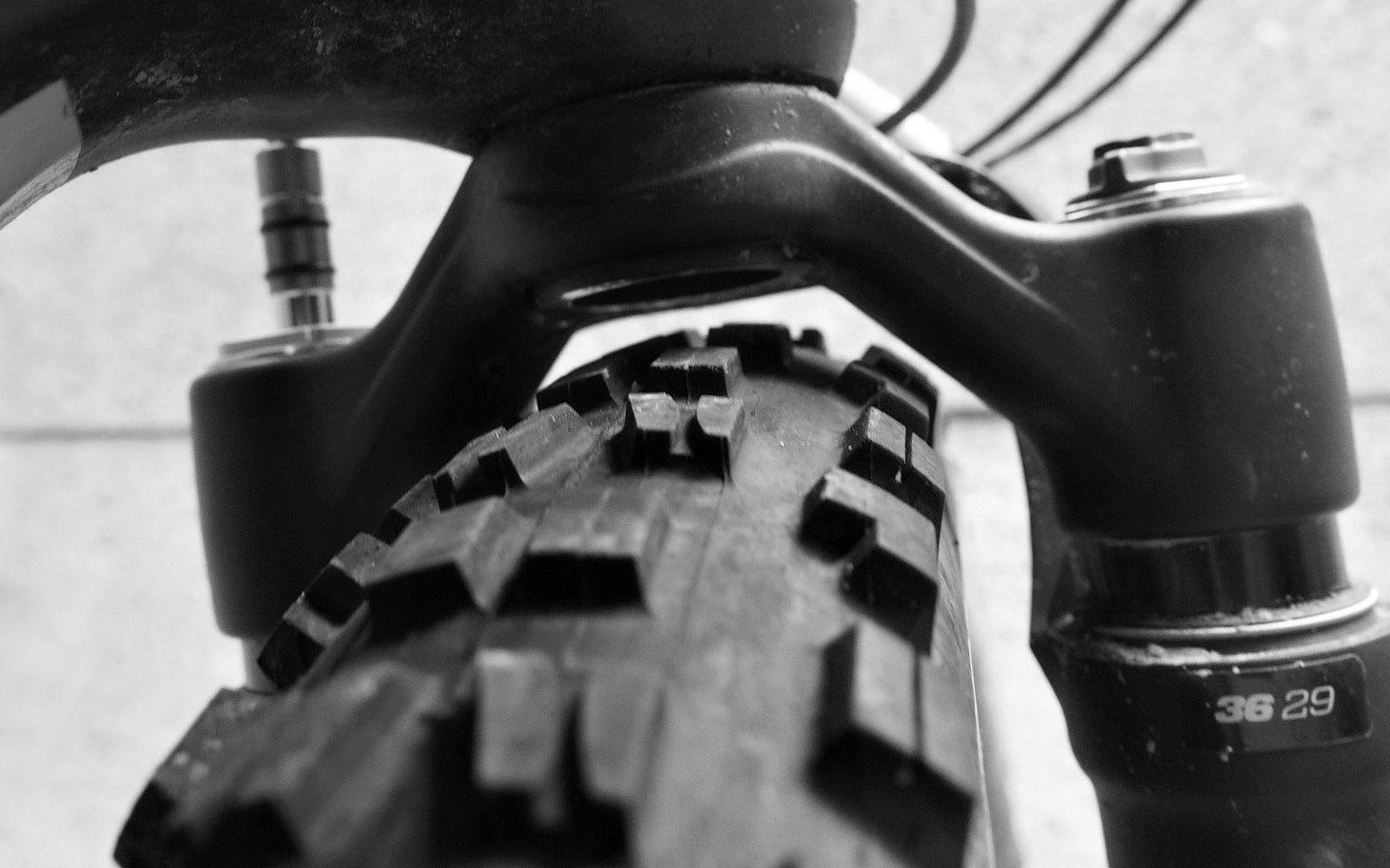
Editorial
Party in the Front? PLUS half of your 29er
Wider Winters
Aggressive PLUS tires, both 27+ & 29+, are ideal for North Shore winters - or anywhere technical terrain and frozen conditions meet. In our off-season they offer more rubber and lower pressures working in tandem to grip nasty sideways roots and Vaseline-varnished rock faces. For winters like the one we experienced last year they boost the fun factor riding in the snow by splitting the difference between a wide standard tire and the new-ride-requiring flotation of a Full-Fat setup.
Many riders with Boost spacing 29'ers have the option to fit a set of 27+ 2.8"/3" wide tires assuming they'll drop[ for an extra set of wheels and rubber. While I love the idea of 4-For-2 it's an expensive proposition, especially for a rider who prefers to run high end hubs and/or carbon rims. For most frames, without multiple geometry settings, the 27+ option also results in a lower bottom bracket height.
But what if your current 29'er can fit a 29+ tire up front? Whether fudging it on a narrower rim or buying a front wheel it's a potentially cheaper, and potentially better riding, option than swapping out to 27+.
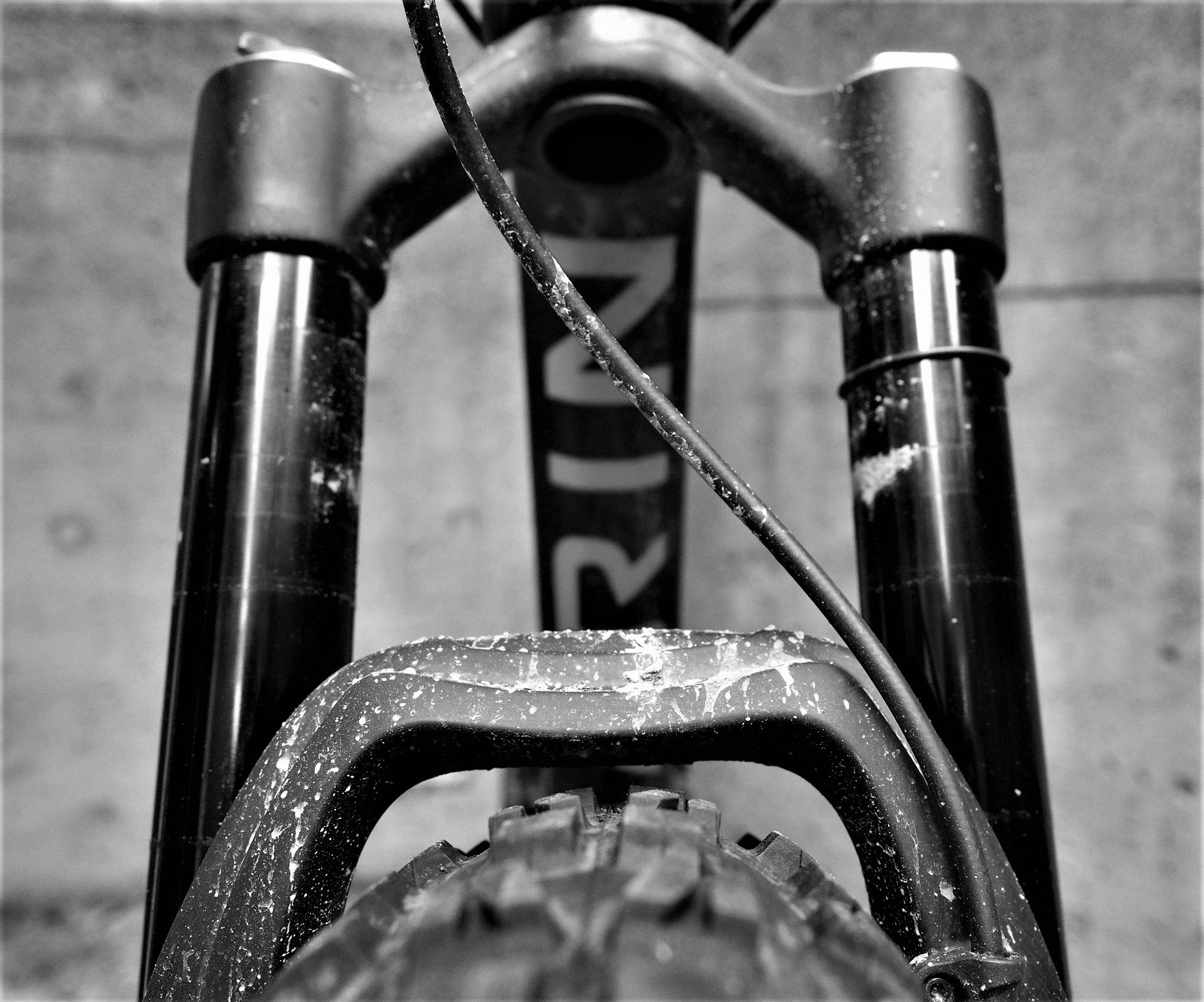
Maxxis Minion DHF 3c 29x3" front arch clearance with a stock Fox 36 29'er Boost Fork.
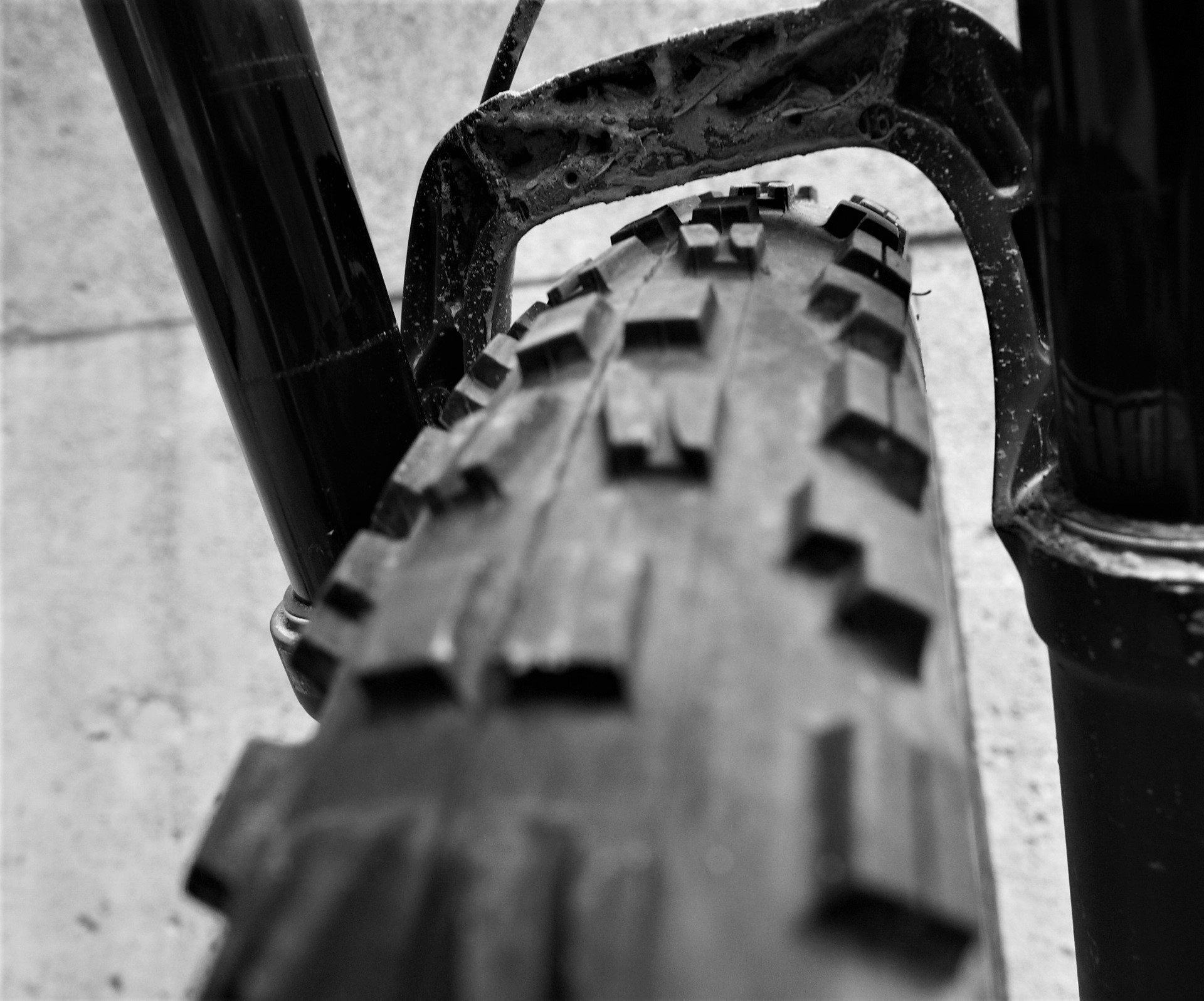
And the rear view.
Fatter Fronts For Life
My first PLUS tire experiences were uninspiring. Going from a 29'er with real sidewalls, aggressive tread patterns and grippy rubber to the first production 27+ tires was a huge step backwards.
Fast forward to my Best Of 2016 picks and I split one of my choices between the 3" wide Maxxis DHF 3C tire and a 40mm wide internal Race Face ARC rim. What changed? In addition to a broader selection of tires and wider rims to support them many manufacturers realized that the big tires running low pressures require real sidewall support.
Then summer 2017 hit and PLUS bikes seemed to be going extinct faster than dinosaurs in a meteor storm. Failure of the initial releases to live up to their hype? Consumer blow-back to the weights of a truly rideable PLUS tire? Neither of the 29+ Minions in my house are floating - at around 1150 grams per.
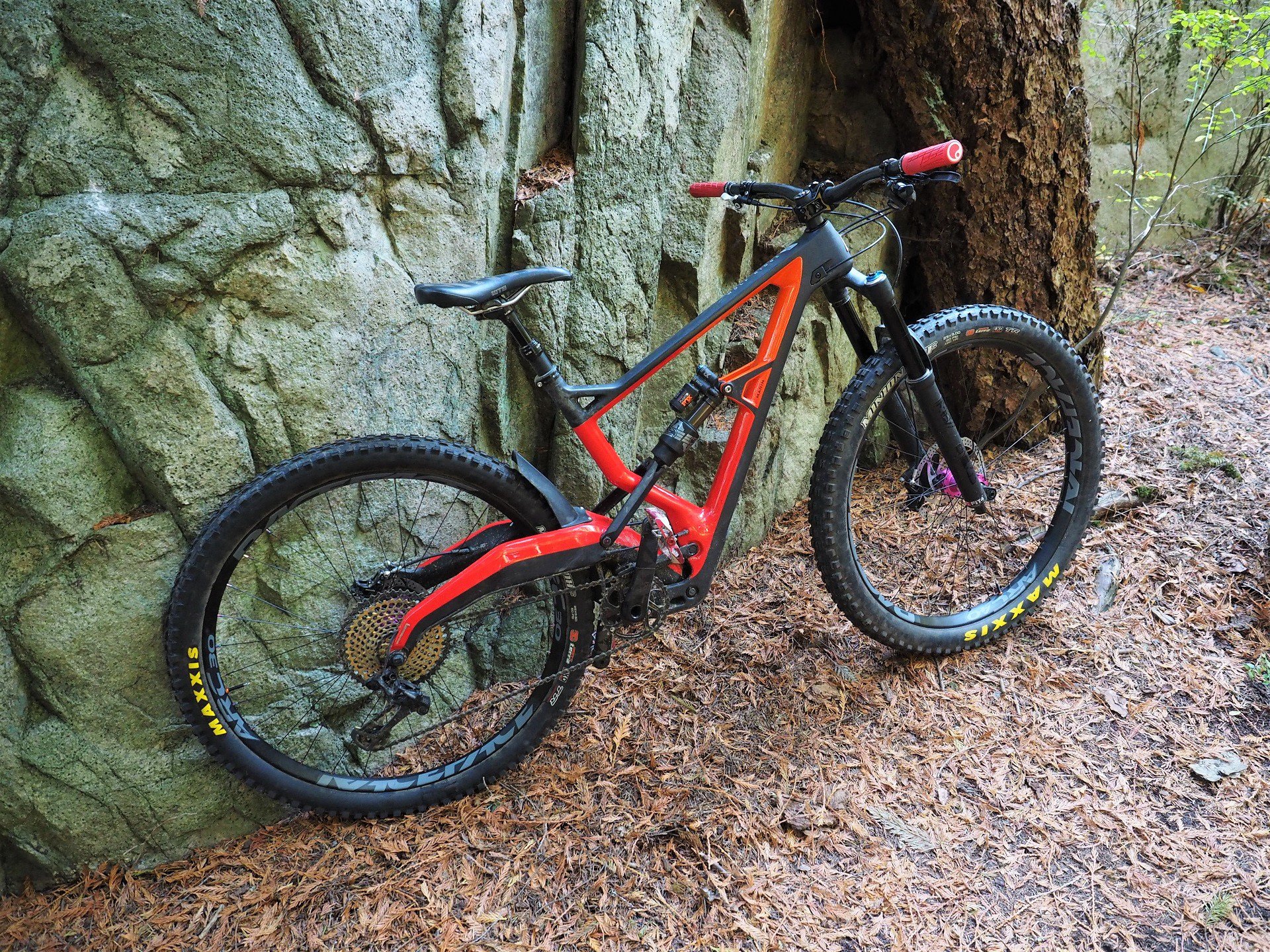
The 2018 Marin Wolf Ridge Pro sporting a 29x2.5" Minion DHF 3c out back and a 29x3" Minion DHF 3c up front. #shenanigans
Marketing efforts behind 27+ bikes have all but evaporated, replaced with 29'ers and 27" bikes using 2.6" rubber that can be made aggressively rideable at a more acceptable weight. Demo fleets that were choked with PLUS bikes last year were more often rolling on 2-9s this season. I can't help but chuckle a bit over all the flak that Niner swallowed over abandoning their 29-For-Life platform - hindsight baby.
29+ was destined to be a niche product so there was no danger of it becoming a flash in the pan, but these days there are always a few companies willing to dabble in the fringes. Quality Bicycle Parts and Trek Bicycles prove that there are lots of weirdos that don't live on the Best Coast.
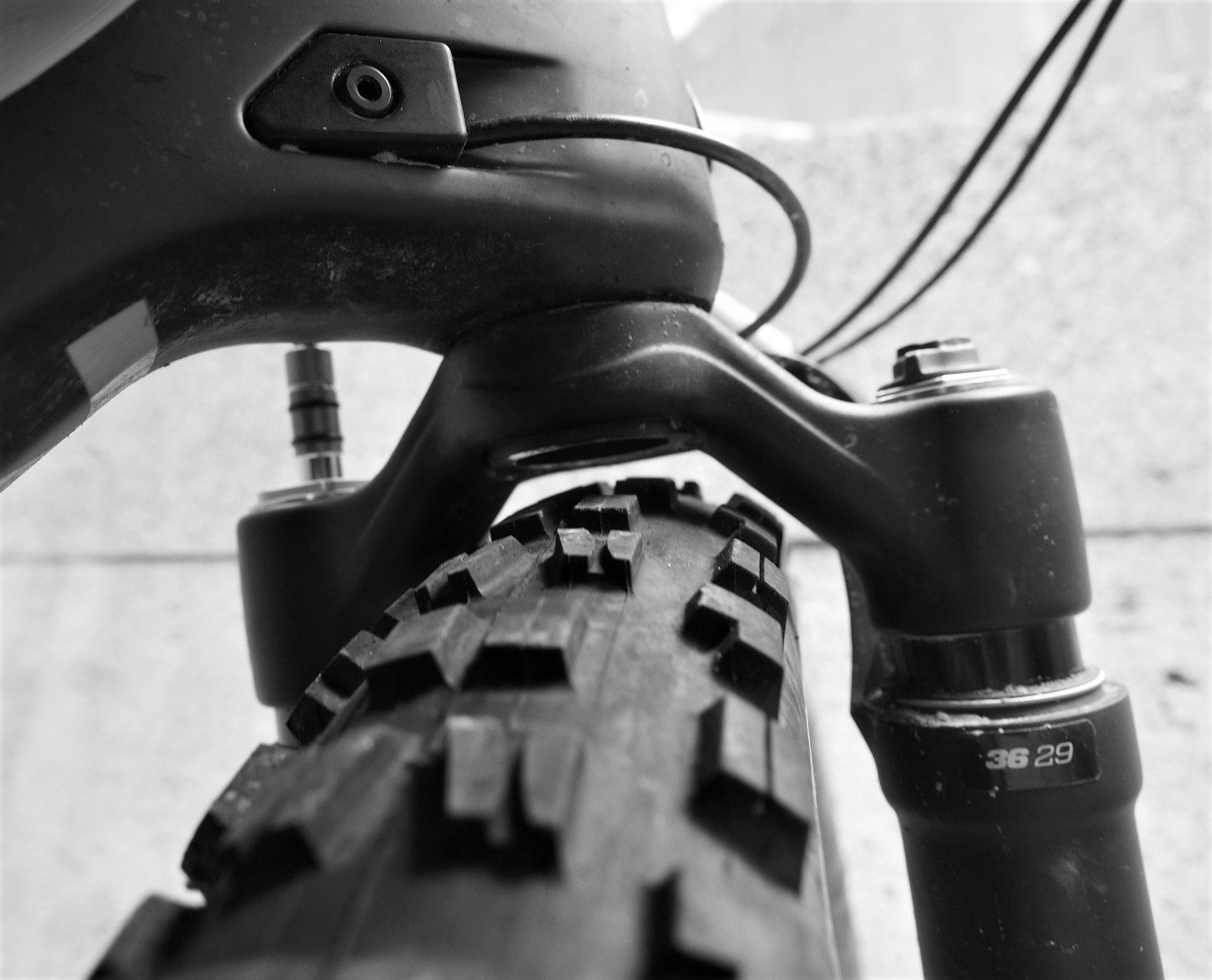
29+ tire clearance with the stock 29'er Fox 36 Boost fully mechanically bottomed.
Proof Of Concept
What started as a quest for more traction on my rigid bike progressed into a ridiculous amount of fun when I slapped a 3" DHF, a top end fork and great brakes onto the front of a Trek Stache test bike. I had to try a 29+/29" setup on our Marin Wolf Ridge tester and that's what I'm currently running on my personal test mule with Manitou's Mattoc mounted.
With a regular North Shore-friendly 2.35" or 2.5" tire out back I don't notice a significant difference climbing PLUS-fronted bikes but the confidence boost pointed downhill on a greasy day is beyond justification. The promise of PLUS with none of the negatives. Well, except for a few hundred grams of unsprung weight up front.
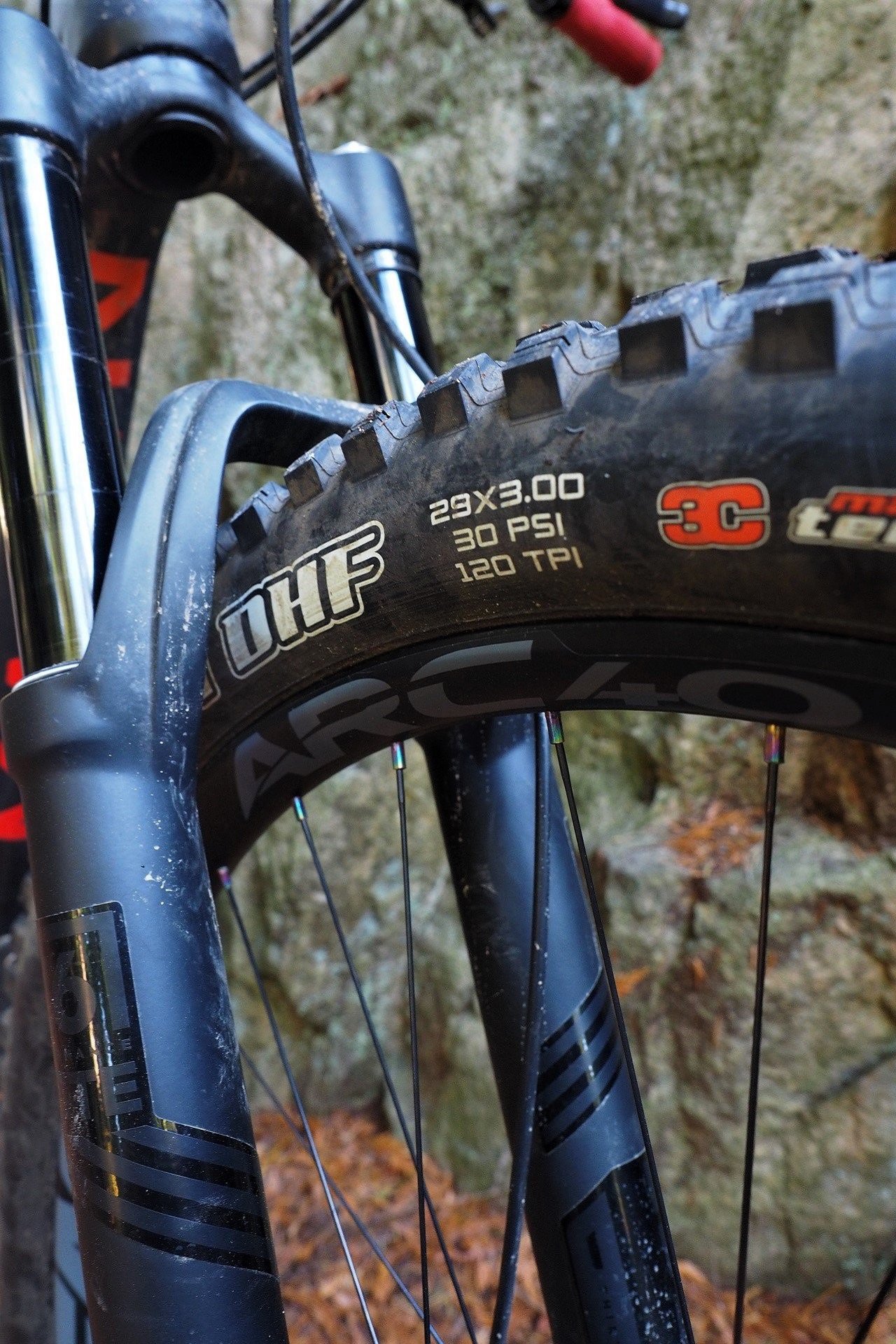
The supple initial front/rear balance between Marin's R3ACT suspension and the Fox 36 FIT 4 is perfect with the 29+ rubber at the head.
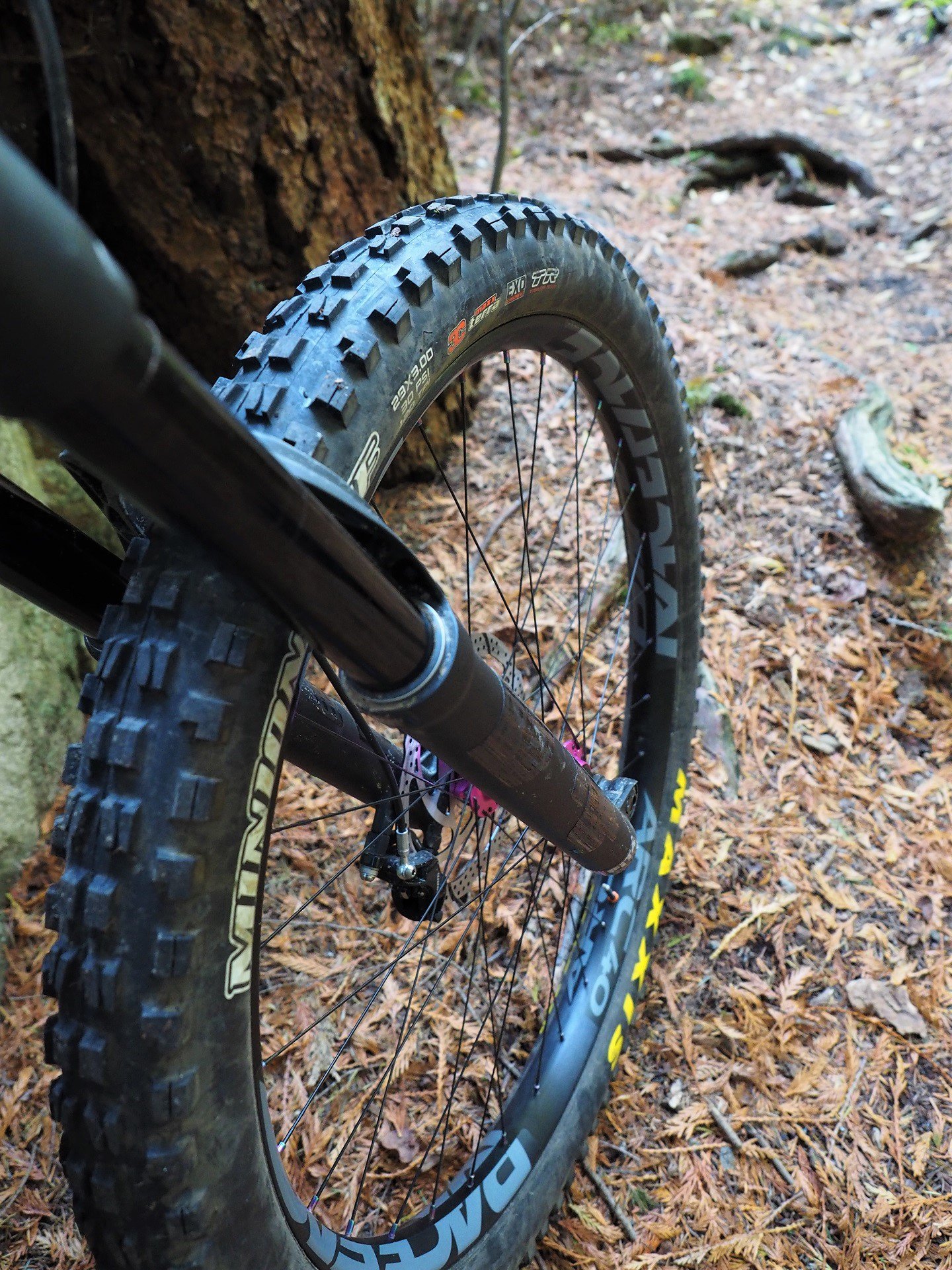
Narrower tires may win carving hard into corners but greasy tech trails in the winter tend to be a more upright affair.
PLUS Size You?
A Maxxis 3c PLUS tire and a suitable wheel aren't cheap but as far as experimenting with bicycle sh*t goes they're a very resellable drop in the bucket to try something unique. That's doubly true after confirming that the combo will fit up for a ride test.
Tire clearance in a stock Fox 36 29+ may not be ideal for really wet snow but I've certainly seen worse. The same idea likely fits with other 29er Boost forks but this is the only one I've tried. I wouldn't add a fender.
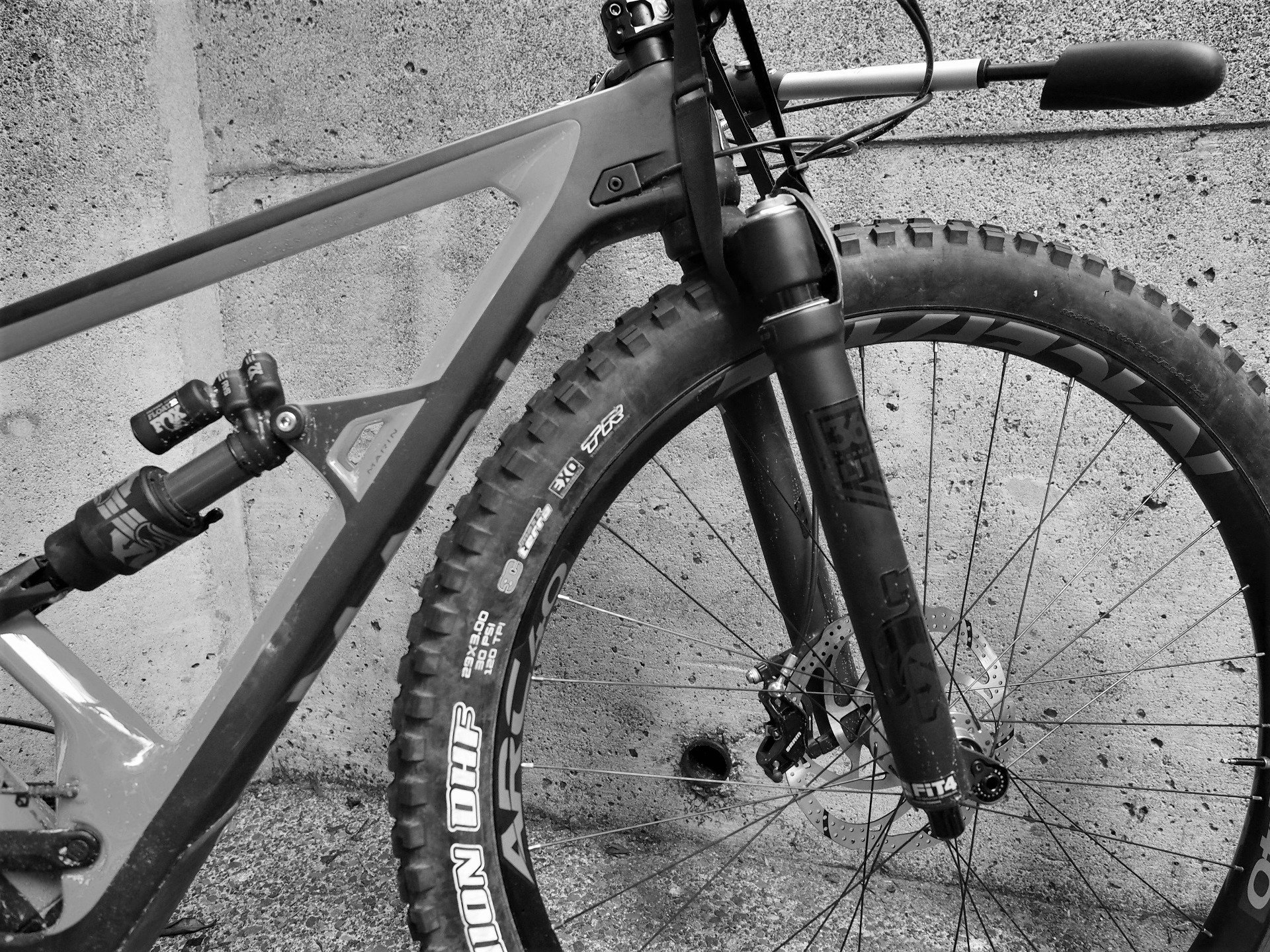
Frame clearance with a 29x3" DHF mounted on a Race Face ARC 40. Full mechanical bottom out. Stock Marin Wolf Ridge PRO with stock Fox 36 29" Boost fork.
If you have been considering 29+* tires up front: do it. For anyone who has been begging for more traction over winter, at any cost, a Maxxis Minion 3c DHF or DHR in 29x3" and a decent aluminum wheel will easily pay for themselves in the added control and confidence.
Just be sure to check tire clearance all the way around including letting all the air out, or removing the coil spring, and bottoming your fork. Mountain biking has enough inherent risk without adding tire-fork contact in bottom out events.
*Having tried both 29+/29+ setups and 29+/29er setups I prefer a regular 29x2.5" tire in the rear. To each their own.







Comments
Lowcard
6 years, 5 months ago
A tire will act like a balloon if you squeeze one side of it, obviously the air will go elsewhere, thus increase the size of the tire on the opposite side. I had this happen while trying to use a Magic Mary 2.5 (2.4?) on the rear of an old bike I had. It had clearance while just sitting there, but under hard compression, the tire would rub the swingarm brace.
My point? Just make sure your tire won't expand enough to strike the arch or you have lots of air in it.
Reply
Andrew Major
6 years, 5 months ago
Great point Wayne! I checked clearance every way I could and have ridden the tire including in rim-strike situations without contact.
The one area of concern may be really sticky snow - it could build up between the tire and arch? I saw this in person on a 26” Fox 32 that had a 27” tire (~zero additional clearance).
It behooves anyone experimenting to confirm those clearances for themselves as well.
Reply
Lowcard
6 years, 5 months ago
I just wanted to throw that out there in case someone tries it and their tire contacts the arch under compression. Could be ugly.
Reply
Andrew Major
6 years, 5 months ago
It’s a great point. Static clearance requirement isn’t max clearance requirement.
Reply
Merwinn
6 years, 5 months ago
"Behooves"
This sure isn't the PB comments.
+1 to you.
Reply
Endur-Bro
6 years, 5 months ago
Had sticky snow this past week clog up the Michelin RockR'2 29 and 36 29er arch. Likely made worse due to the Marsh guard on the fork. Once I was up to speed the snow would self clear out of the lugs. But pushing up through all the downed trees with a stuck from twheel isn't fun.
Reply
Andrew Major
6 years, 5 months ago
I've had lots of issues in sticky snow with build up behind a Mucky Nutz / Marsh Guard etc - one EPIC high speed endo at Cumberland a few years back where I had time to try flapping my arms for more lift. But once removed I had no more issues even with tight clearance in terms of snow clearing itself.
I know a couple of people with non-Boost DVO Diamond forks running 2.5" Minions and 2.35" Magic Mary's and the clearance at the top is really tight. No problem with snow clearing last winter sans fender.
We had some pretty sticky snow last year for Vancouver, but - like mud clearance and... well... everything - gear reviews/editorial always needs to be read through the lens of local conditions.
Cheers,
Reply
AlanB
6 years, 5 months ago
Zero arch clearance in the snow isn't a problem. It's an advantage!
Note how the arch scrapes excess snow off my front tire. You can see the tread blocks through the snow.

No, this would not work well with a Mucky Nutz fender.
Reply
Andrew Major
6 years, 5 months ago
Great photo - and interesting point - Alan!
AlanB
6 years, 5 months ago
It may be a great photo, Andrew, but picking up stones in the tread wasn't so great. Maybe, just maybe a little more clearance would be better.
Cooper Quinn
6 years, 5 months ago
There's.....significant tire expansion?
I'm not saying I don't trust you Waybe, (well, no. I know I don't trust you. hahah), but I would have assumed tires were far more static than that. I can see the pressure increasing, certainly... but struggle to see the actual tire expanding. Kevlar is pretty static.
I can see wheel flex being a big factor for this, though.
So..... easy solution, though.... just pump tires up to like 50PSI to test for clearance?
Reply
Andrew Major
6 years, 5 months ago
*Edit - more intelligible response...
Most of the deformation is happening where the tire hits the ground not at the arch/crown but I think what Wayne is saying is the sidewalls will expand all around the tire (like a balloon) with a spike in pressure at the trail. I think that makes sense.
...
Interesting point re. overinflating. I wonder what the pressure inside a tire is in a bottom out situation?
Say 2.5” rubber at 30-psi to rim strike? It would be greater in a tire like DD where there is much less sidewall flex but even then it probably isn’t even double?
Reply
Mike Acton
6 years, 5 months ago
Sweet!!!
Hey Andrew, how was tire clearence in the back for a 29+, did you try by any chance? I've got a wolf ridge also, and would be keen to give this set up a go.
Thanks!
Reply
Andrew Major
6 years, 5 months ago
Hi Mike,
Definitely not clearance in the back for 3”.
There is good clearance for a 2.5” Minion DHF on Arc 30 rim. So max clearance is between those two points.
I’m personally a big fan of Plus up front and a smaller (WT or +/-) tire out back.
Reply
Vik Banerjee
6 years, 5 months ago
I've had a 29+ bike since that was a thing back in 2014. I've tried a bunch of different tires/widths on my bikes. One thing I have never wanted was a big tire up front and a smaller tire in the rear. With some much weight on the back wheel that's where having the extra volume of a wider tires pays a lot of dividends.
Reply
Andrew Major
6 years, 5 months ago
Pays a lot of dividends in what riding situations Vic? What tire are you running in rear? Sport surface?
Having ridden 29+ Fr/Rr and a mixed setup I prefer 29+/29”. Both my personal bikes are built that way - in addition to riding it on the WR.
The caveat is I’m not thinking of 29+ as a fat bike (26x5 / 27x4 / 29x3) and running light semi-knob tires. No traction issues on regular terrain climbing/descending a 2.5” Minion out back. I’m mainly looking for improved performance descending by running 29+ up front.
I also find the bikes corner better with the non-Plus rear tire.
Reply
Vik Banerjee
6 years, 5 months ago
The dividends of having more volume - improved ride quality, improved flotation & better traction. I've never had a situation where I wanted the rear tire to be narrower. This isn't just a comment about Plus vs. non-plus. The rear wheel of a bike has the most weight on it so it benefits from running a wider tire more than the front.
Reply
Metacomet
6 years, 5 months ago
I think a lot of it depends on what you are looking for out of the bike. As in, how/where you intend to ride it, how you want the bike to behave overall, what the conditions are like, and what kind of compromises you are willing to make in order to achieve whatever you are trying to accomplish.
In my own experiences, I tend to prefer wider front tire and narrower rear same as Andrew, but the priority of it depends entirely on the bike and the conditions.
Findings and logic behind that for myself come a lot from what my preferred/ideal tire pressure would be for the given conditions/location/riding habits.
Where do you personally want the extra traction and compliance, and where do you want the impact protection and directness? For myself on my hardtail and FS, I like the compliance afforded by lower pressures on the front tire more. At the plus tire widths and fairly soft/wet/ leaf covered/and loamy dirt, tire roll, self-steer, and bottoming out are not as much of an issue for me on the front, and I am prioritizing the predictable grip afforded by the fat footprint.
For the rear tire, bottoming out and pinching, and tire roll are still much more of a concern in the conditions I would want to be riding the plus tires, so I am prioritizing support and bottom out resistance afforded by higher pressures and generally a slightly narrower tire. Also, if I am not overly struggling with drive/braking/cornering traction on the rear that cannot be overcome by a more aggressive tread pattern, then the plus sizes there becomes a lot less necessary for myself and can be counter productive as the tire will become bouncy at the higher pressures required to prevent damage/pinch flats and tire roll.
On the fatbike, my needs change with the conditions, so I tend to run a slightly higher front pressure for better steering precision, and lower rear pressure for better compliance, less bounce, and better drive traction in awful conditions where grip/compliance/flotation are my only major concerns.
I don't think there is a wrong approach either way if you know what works for you and what you are trying to prioritize.
Cheers!
Reply
Andrew Major
6 years, 5 months ago
Thank you. That articulates my experience to the letter :-).
Reply
El-Train
6 years, 5 months ago
I agree with Vik, and the setup I would love to try is a 27.5+ rear, with normal 29 front. Like a Big Honzo with a 29er front wheel. Like a dirt bike. Precise steering, and a little extra cush in the back. The bigger the front tire in my experience, the worse the steering behavior is, regardless of traction improvements. Never seen anyone talk about this setup but I think it would be very good.
Reply
Andrew Major
6 years, 5 months ago
For context where do you live/ride and what are the conditions like?
Locally front wheel traction on steep descents with varying sport surfaces is generally what’s on most people’s minds.
Reply
Michael
6 years ago
Andrew I know your open minded enough to try a 27.5+ rear and a beefy 29 in the front...
Reply
UFO
6 years, 5 months ago
On my Chromag I've been very happy with a 29×2.35 front Hans Dampf and rear 27.5x2.8 Rocket Ron (I do also have a 2.8 Nobby Nic as well I should probably throw on for the wetter riding)
I keep all the traction and compliance of the + rear tire, and also benefit from the higher bb and sharper more accurate steering with the normal 29 front tire.
Reply
[user profile deleted]
6 years, 5 months ago
This comment has been removed.
Andrew Major
6 years, 5 months ago
I’ve ridden Schwalbe Procore quite extensively - which is essentially a pneumatic adjustable Cushcore system - the ride is very different between that and Plus.
Reply
Endur-Bro
6 years, 5 months ago
Unsure if there is enough stays clearance on my frame but running a 275+ DHRII or the like in the rear could be mucho fun. Or it could be tragic! Who knows? My bb would be dangerously low.
Reply
Michael
6 years, 5 months ago
I've not had a problem running the 29+ DHF/DHR combo on my Krampus it's pretty awesome from a traction point of view. I'm not sure it's any better than a WT 2.5 which also seems to provide a metric ton of traction. Running a smaller wheel in the back is an interesting idea and likely inevitablly harsher riding but the slightly slacker head angle and much faster rolling wheel may offset the pain ;) one thing about those Maxxis DHF/DHR 29+ in the 3C is they are sloooow rolling beast tires!
Reply
Andrew Major
6 years, 5 months ago
Easy enough to borrow a regular 29’er wheel/tire and let us know what you think :-)
Reply
Kenneth Perras
6 years, 5 months ago
Hey Mandrew, FYI that fork will go to full bottom, with the o-ring right up against the crown, once the bottom out bumper fully compresses. Might want to add another token with the same PSI as an aid to prevent that.
Reply
Andrew Major
6 years, 5 months ago
Hi Ken,
When I bottom out at speed (with this tire combo) the o-ring will sit all the way up at the crown (I assume due to momentum) but I confirmed on this fork that this is hard bottom. Just over 1cm from crown/seal contact.
I know a couple people running this same setup in Fox 34 forks and they had to add ~1cm spacers to the lowers to change the hard bottom out point.
Reply
Alex D
6 years, 5 months ago
This is one trend I can speak to directly. I've been running my Scalpel with 39i/WTB Ranger 3.0" up front and 29i/XR2 2.5" (2.35" claimed) out back for over six months. I couldn't fit anything bigger in the back with adequate clearance, so it's not a true 29+ bike. A byproduct is that the head angle is slacker by about half a degree.
The goal was to have more grip and better rollover. The bike came with 18i rims and Schwalbe 2.1" RaRa tires that measured out to 2", which made for a firm, unpleasant ride that required constant line vigilance even on mild terrain. I could rarely sit and spin. Front-end breakaway was abrupt.
I initially replaced the Ralphs with a Forekaster 2.35 / Ardent Race 2.35 combination. Not bad. Considerably better grip and probably ideal for XC, but still short of rollover. (I'm in the Southeast, it's just constant roots.) Hence the new wheelset (carbon, exactly the same weight as the original despite the width difference.)
Some impressions:
Weight differences are marginal. The Ranger (and Chupacabra, a very similar tire) is 880g. The Forekaster, probably the lightest tread pattern I'd want up front in a regular size, is 735g. Bonty's XR4, more like 780g. The extra weight and inertia is noticeable, but modest.
Steering is slower. Not so much on 70mm and 80mm stems (with 780mm bar, 70.5D HA, 45mm offset), but when I went to 90mm to bring my weight forward (the bike came with ~110mm), it took a few miles to stop blowing turns. Very stable. Lethargic, even. It takes more body english to chuck the bike around.
Tire pressure is enormously important. I verify my Ranger is at 14 PSI before every ride. More pressure makes for a bouncy ride and less grip. It's still better on both counts than a smaller tire with a similar tread pattern, but (at suboptimal pressure) a smaller tire with bigger treads would be preferable. Undershooting by a few PSI results in autosteer that makes the bike totally unrideable. There's no question that some negative Plus experiences arose from poor setup.
Traction is way up in dry conditions. (I don't ride when it's wet.) I can brake whenever; the limiting factor is always weight balance and the Lefty packing down. If my body position is right, the bigger tire sticks like flypaper on most terrain. Dusty loose-over-hard flat turns are still challenging; it's actually better if there's some chunder for the tire to deform around and grab.
(Cont'd)
Reply
Alex D
6 years, 5 months ago
Ride quality is wildly better. The bigger tires filter a lot of the smaller cruft, enough that I can stay seated on most uphills if I want, and the Ranger doesn't hang up on anything on the downhills. Big confidence booster. Plus isn't a replacement for suspension, though; with my suspension locked out, big hits are still big hits. I don't yearn for a rigid.
Rolling resistance is higher, though I think as much from the wide rims as the tire width. This is unavoidable; a big contact patch rolls slower.
Acceleration isn't what it was. It's less about weight than the extra squish when I'm out of the saddle. Even with lockouts, the bike doesn't have the responsiveness it originally had, and this, I think, is also unavoidable. A friend's 27.5+ hardtail with 3" tires on both ends was much worse, much squishier. Keep the momentum up and the big tires flow beautifully, but sprints aren't as rewarding.
Some conclusions:
I like the split tire sizes. The smaller back wheel still gets hung up on hard edges on uphills, but that's about the only disadvantage (of this particular 2.5" tire) relative to 3" tire. I can unweight it on bigger obstacles, so I don't think extra rollover would outweigh the directness and reduced rolling resistance (on most terrain) from a smaller tire.
I don't like how much the 3" tire dulls the bike. I'm looking at switching the Ranger to a Nobby Nic 2.6 or a Tervail Cumberland 2.8 to get bigger side knobs and a more positive feel when I'm pushing hard. Absent that, I still prefer the existing configuration to the 2.35" and 2.1" tires I used previously.
I'm not sure if a smaller front tire would be faster. 29+ doesn't feel as fast, but that's deceptive when it's just rolling over things that smaller tires would hang on. TBD when the Ranger wears out enough to merit replacing.
Reply
Andrew Hamilton
6 years, 5 months ago
Thinking about doing some variation of this for my Enduro 29. Seems money in the steep/loose/wet but how does the 3.0 initiate into berms/flat hard corners?
Reply
Andrew Major
6 years, 5 months ago
For the record I’m certainly no Jared Graves in terms of speed carried or explosive cornering technique.
I find the aggressive Plus rubber isn’t a benefit on smooth trail (berms for example) compared to say the same rubber in a 2.5”. It doesn’t cut in as well and it rolls slower.
As soon as said berm is a bit blown out, littered with braking bumps or the flat corner has greasy rock armor or exposed roots we’re back to Plus being a net benefit. Again assuming an aggressive well supported tire like my DHF. Light/thin sidewall Plus tires are a different animal.
Measuring by the clock (or considering what the tires would weigh to hold up to EWS riders) I doubt you’ll see Plus being raced aggressively. Unless if all we were riding was smooth berms / flat corners I think most of us would be happy with Plus performance in those situations and by fun factor happier overall as a net.
I do prefer smaller rubber in the back (with aggressive side knobs) as I find it hooks up harder/more predictably and rim durability is much improved.
Reply
Art S
6 years, 5 months ago
I'm running a 27.5x3.0 Dirt Wizard on the front of my Enduro 29. In loose conditions with a 45mm internal rim it is head and shoulders the best front tire I've ever run. Hands down better than the Butcher, DH-F or TRSr. It is about a 1 cm shorter than a 29" tire and isn't light but it is super long lasting and durable. I don't mind it at all on hardpack but it's not much of an advantage there. I also tried a few 2.8's on the rear and they made the bb too low for technical climbing. I may try the upcoming 29x2.5 aggressor but am pretty happy with the 2.3 back there.
I also tried a 29x3 Dirt wizard a few times. I only had a 33mm internal rim and that wasn't wide enough to get the side knobs to work. Regardless I thought it made the bike feel a little slow side to side.
To offset the shorter 27.5 front tire I'm running a taller headset base plate that specialized made when they cobbled together their first 27.5 enduro's.
Reply
Please log in to leave a comment.